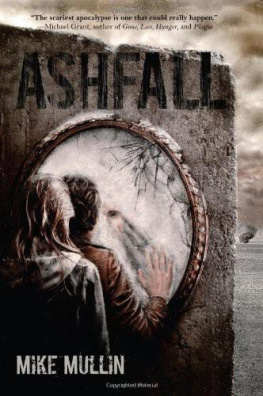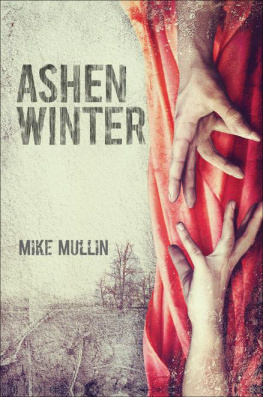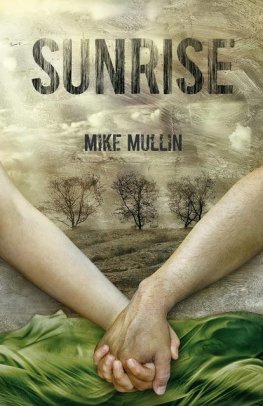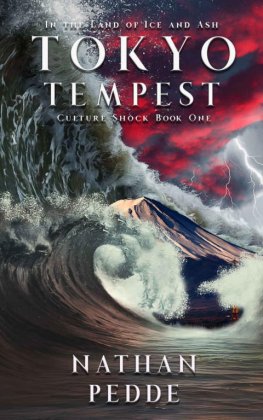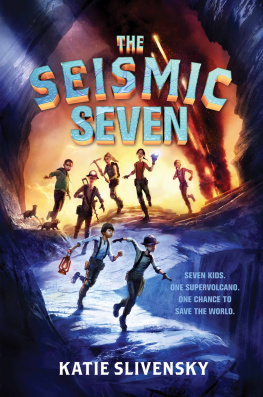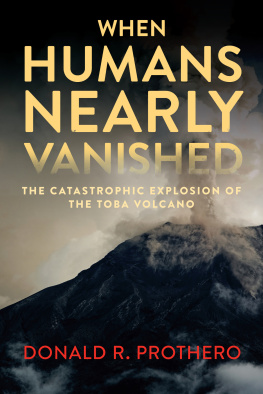There is a colossal volcano under Yellowstone National Park. The volcanos caldera, or crater, is visible in some places as a ring of cliffs and measures roughly 34 by 45 miles. It has erupted three times in the last 2.1 million years, events so powerful they are usually classified as supervolcanoes. The largest of these eruptions released about 2,500 times as much magma as the 1980 Mount St. Helens eruption.
Its often said that the Yellowstone volcano is due for another eruption, since the last three were 640,000, 1.3 million, and 2.1 million years ago, respectively. Actually, its extremely unlikely that the volcano will explode in our lifetime. The eruption preceding the last three was 4.2 million years ago, so the regularity of the most recent events is deceptive.
The problem with writing a book set in the aftermath of a volcanic supereruption is that no supervolcano has exploded in recorded human history. So in describing it, Ive had to make do with scientific speculation and accounts of survivors of normal, or Plinian, eruptions such as Mount St. Helens in Washington State and Krakatoa in Indonesia.
For example, early in this book, Alexs house is hit with a piece of rock thrown 900 miles by the volcano at supersonic speed. Plinian volcanoes dont do this; all the heavy material they eject falls near the volcanos vent, and only the much lighter ash travels farther. Some scientists believe supervolcanoes behave differently, blasting chunks of rock on ballistic trajectories from deep pipes in the lithosphere (the solid part of the earth consisting of the crust and outer mantle), but this view is controversial.
The loudest sound in recorded history was probably Krakatoas eruption on August 27, 1883 in Indonesia. That eruption was audible almost 3,000 miles away on the island of Diego Garcia in the Indian Ocean. There, it sounded like the roar of heavy artillery for several hours. Yet the Yellowstone supereruption 2.1 million years ago was about 120 times more forceful than Krakatoas blast.
The ashfall Ive depicted in the book is similar to what Yellowstone released 2.1 million years ago. This amount of ash would have darkened the skies for months, possibly years, and caused a global volcanic winter lasting a minimum of three years. Ash particles are tiny and electrically charged, so they are often associated with lightning storms. They can also cause odd weather effects, usually abnormally heavy precipitation in the short term, followed by years of drought.
No one knows exactly how much warning wed get before an eruption at Yellowstone. Its possible it could happen suddenly, but more likely there would be years of earthquakes and topographical changes to warn us. Whether wed prepare adequately, even if given enough warning, is another question, of course.
If youd like to read more about the science behind Ashfall, the following books are a good start:
Supervolcano: The Ticking Time Bomb Beneath Yellowstone National Park by Greg Breining. MBI Publishing, 2007. Provides an excellent overview of the history and geology of Yellowstone. Includes an account of major volcanic events that have impacted humans and speculates about the possible consequences of a Yellowstone supereruption.
Supervolcano: The Catastrophic Event that Changed the Course of Human History by John Savino, Ph.D. and Marie D. Jones. Career Press, 2007. Contains information on supervolcanoes around the world, including Yellowstone (Wyoming), Long Valley (California), and Toba (Indonesia). Chapter 10 is an interesting fictional account of a future supereruption at the Long Valley volcano.
Krakatoa: The Day the World Exploded, August 27, 1883 by Simon Winchester. HarperCollins, 2003. An exhaustive and beautifully written account of the biggest modern Plinian eruption.
Catastrophe: An Investigation into the Origins of the Modern World by David Keys. Ballantine, 1999. Describes how a volcanic event in 535 A.C.E. changed civilizations across the globe. Very useful for considering the possible political, social, and epidemiological consequences of a supervolcano.
First and foremost, my thanks go to my mother and father, Shirley and Stan Mullin. Without their unwavering support, Ashfall would not exist. Im also grateful to Helen-Louise Boling for her feedback on Ashfall and for being the good kind of mother-in-law.
Thank you to Ian Strickland, who showed me Ashfall through a teens eyes and boosted my confidence, and to Dorothy Menosky, who showed me Ashfall through a teachers eyes and boosted my humility. It is a better novel for their input.
To everyone at Critique Circle who gave feedback on pieces of this novel (Angela Ackerman, Ardyth, Vicky Bates, Darla Davis, Liam Deihr, Karla Gomez, Gorse_wine, Greenguy, Molly Hart, Katy, Helen Kitson, Audrey Koudelka, Andrea Mack, Martha 2150, Memyselfi, Shannon OFarrell, Quotelover, Sky, Tamamushi, and Elizabeth Taylor), thank you. I also appreciated the generous advice Jim McCarthy offered, if not the rejection that accompanied it. Ashfall improved dramatically due to his insight.
Im grateful to Pete Matthews and Erin Stoesz, who volunteered their geology expertise to ferret out scientific errors in Ashfall. Any errors that remain are mine alone.
I owe my publisher and editor, Peggy Tierney, an unpayable debt for her steadfast belief in Ashfall and patience with me as we worked to make it the best book it could be. I came to dread her emails that read, Could you rewrite the ending, just one more time? But she knew exactly what the novel needed, and the blame falls on me for taking six tries to get it right.
Lisa Rojani Buccieri did a masterful job editing Ashfall... twice! Ive placed the only exclamation point in these acknowledgments in her honor. She made my writing better than I believed it could be. Thanks to Dorothy Chambers for saving me from unspeakable embarrassment. To Ana Correal, who brought the emotional subtext of Ashfall to life through her cover art, thank you. I also appreciated the help Gabe Tierney offered in regard to the first chapter and cover.
Mrs. Parker and Mr. Wesson at Indianapolis ATA Black Belt Academy showed nearly superhuman patience and per severance in teaching me the taekwondo that became such an important part of Ashfall. Thank you both.
Thank you to my brother, Paul Mullin, for his help with Darlas Macgyver moments. Also thank you to Paul, Caroline, Max and Anna for teaching me about goats, ducks, and greenhouse farming.
A huge thank you to Larry Endicott, who is such a brilliant photographer that even I look good in his camera lens. Thanks also to Mab Graves, who provided cheerleading and much needed help with artistic questions.
Ive been thrilled and humbled by the support of the authors, booksellers, librarians, and teachers who read Ashfall and offered advance praise: Charles Benoit, Cinda Williams Chima, Carol Chittenden, Robert Michael Evans, Michael Grant, Carl Harvey, Kathy Hicks-Brooks, Christine Johnson, Saundra Mitchell, David Patneaude, Richard Peck, and Dave Richardson.
And most of all, thank you Margaret: my wife, first reader, best friend, and true love.

Photo by Larry Endircott
Mike Mullins first job was scraping the gum off the undersides of desks at his high school. From there, things went steadily downhill. He almost got fired by the owner of a bookstore due to his poor taste in earrings. He worked at a place that showed slides of poopy diapers during lunch (it did cut down on the cafeteria budget). The hazing process at the next company included eating live termites raised by the resident entomologist, so that didnt last long either. For a while Mike juggled bottles at a wine shop, sometimes to disastrous effect. Oh, and then there was the job where swarms of wasps occasionally tried to chase him off ladders. So hes really hoping this writing thing works out.

